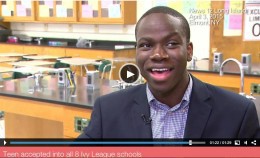Let’s Reminisce About College Admissions!

It’s college admissions season, which means we’re getting fun news items like this one in the New York Times about how higher education is so expensive that, to send his two kids to school, even the mayor of the richest city in the richest country in the world probably has to apply for financial aid.
the college process has cast Mayor de Blasio as a curious test case: His family is now affluent by most standards. Mr. de Blasio is paid $225,000 as mayor and the family receives tens of thousands of dollars in rental income from two properties in Park Slope, Brooklyn.
And yet, the de Blasio family’s argument for aid would not be unreasonable, according to financial aid experts — a striking testament to the increasingly extreme costs of higher education.
The mayor’s daughter, Chiara, attends Santa Clara University, a private Jesuit institution where tuition, room and board is roughly $55,000 a year. If Dante were to attend Yale, for example, tuition, room and board would come to about $60,000 a year.
Particularly with two children in college, the six-figure income “is not going to disqualify him from demonstrating need,” said Kalman A. Chany, president of Campus Consultants, a firm based in Manhattan that advises families on financial aid.
If de Blasio chooses Brown, he might end up rubbing shoulders with Michaela Kennedy Cuomo and Malia Obama. I wonder what sort of financial aid packages the first daughter of New York and the first daughter of the United States of America qualify for.
If de Blasio does choose Yale, he will likely end up a classmate of Harold Ekeh, the Nigerian-born child of Target workers who got into every school he applied to, including the entirety of the Ivy League, but who is leaning towards Yale. Because the Bulldogs are offering him the best aid package? Even CNN Money doesn’t say. Is the topic of finances too distasteful for you, CNN Money? When did you get so squeamish? Ekeh has four younger brothers. How will he afford not merely tuition and room and board but books and other expenses? How will they? Inquiring minds want to know!
Instead, our inquiring minds have to be satisfied with CNN’s focus on Ekeh’s bootstrapping accomplishments and his “humility.”
Outside of the lab, Ekeh directs a youth choir at his church, plays the drums, is part of Key Club and Model UN and was elected to the Homecoming court. He speaks Igbo and Spanish and has a 100.5% GPA. He’s proud of acing the AP History Exam despite his early struggles with the subject.
Elmont High School is 99% minority. Ekeh is the second student in recent years to win a prestigious Intel Science award.
He credits his success to hard work and perseverance, which is super, and I understand why Fox is so fond of him. But lots of people from less affluent families work hard and persevere and still don’t make it or have a hard time once they arrive on campus. Hopefully Yale, or whatever school Ekeh chooses, will help support him materially and in whatever other ways are necessary; it’s a waste to bring such talent to a place and then not know how to retain it.
Why is college so increasingly, infernally expensive, anyway? Paul Campos tells us it’s not for the reasons we think:
over the past 35 years, college tuition at public universities has nearly quadrupled. … far from being caused by funding cuts, the astonishing rise in college tuition correlates closely with a huge increase in public subsidies for higher education. If over the past three decades car prices had gone up as fast as tuition, the average new car would cost more than $80,000. …
Appropriations per student are much higher now than they were in the 1960s and 1970s, when tuition was a small fraction of what it is today.
And the rise isn’t attributable to the salaries of professors either:
Salaries of full-time faculty members are, on average, barely higher than they were in 1970. Moreover, while 45 years ago 78 percent of college and university professors were full time, today half of postsecondary faculty members are lower-paid part-time employees, meaning that the average salaries of the people who do the teaching in American higher education are actually quite a bit lower than they were in 1970.
What is it, then, that accounts for the astronomical rise in prices?
a major factor driving increasing costs is the constant expansion of university administration. According to the Department of Education data, administrative positions at colleges and universities grew by 60 percent between 1993 and 2009, which Bloomberg reported was 10 times the rate of growth of tenured faculty positions.
Even more strikingly, an analysis by a professor at California Polytechnic University, Pomona, found that, while the total number of full-time faculty members in the C.S.U. system grew from 11,614 to 12,019 between 1975 and 2008, the total number of administrators grew from 3,800 to 12,183 — a 221 percent increase.
The rapid increase in college enrollment can be defended by intellectually respectable arguments. Even the explosion in administrative personnel is, at least in theory, defensible. On the other hand, there are no valid arguments to support the recent trend toward seven-figure salaries for high-ranking university administrators, unless one considers evidence-free assertions about “the market” to be intellectually rigorous.
Support The Billfold
The Billfold continues to exist thanks to support from our readers. Help us continue to do our work by making a monthly pledge on Patreon or a one-time-only contribution through PayPal.
Comments